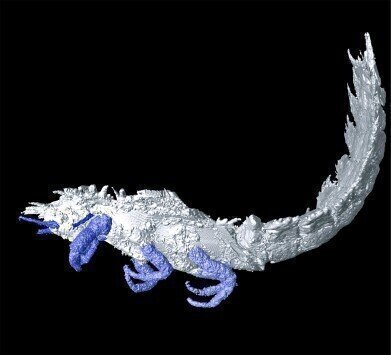-
 Reconstructed model of a sharp spined insect
Reconstructed model of a sharp spined insect
News & Views
Images of 300 million old insects revealed
Sep 27 2012
Stunning 3D images of 300 million-year-old insects have been revealed for the first time by University of Manchester researchers who used a high resolution form of CT scanning to reconstruct two 305-million year old juvenile insects.
Without the pioneering approach to imaging, these tiny insects – which are three-dimensional holes in a rock – would have been impossible to study.
By placing the fossils in a CT scanner, and taking over 3,000 X-rays from different angles, the scientists were able to create 2,000 slices showing the fossil in cross section. From these slices the researchers created 3D digital reconstructions of the fossils. This process allows them to learn more about the lifestyle, biology and diet of the insects, one of which is similar to a modern day cockroach, and glimpse fascinating insights about how both were adapted for survival.
One of the insects reconstructed by the scientists is characterised by a large number of sharp spines. It is a new species and genus which does not exist today. The other is an early predecessor of one of the great survivors of the insect world, the cockroach, and is one of the best preserved examples of this age ever seen by insect palaeontologists. Researchers suspect from its well preserved mouthparts that it survived by eating rotting litter from the forest floor.
Both are members of a group called the Polyneoptera – which includes roaches, mantises, crickets, grasshoppers and earwigs.
Lead scientist Dr Russell Garwood of the University of Manchester’s School of Materials said: “The most dramatic change is seen in insects like butterflies, which change from a larva, to chrysalis, to adult. But relatively few people look to the fossils to try and work out how such a life cycle may have evolved. We are hoping that work like this will allow us to better understand the biology and development of these early insects, and how major innovations may have come about."
Tomographic Reconstruction of Neopterous Carboniferous Insect Nymphs, by Russell Garwood, Andrew Ross, Daniel Sotty, Dominique Chabard, Sylvain Charbonnier, Mark Sutton and Philip J. Withers, has been written for PLoS One
Digital Edition
Lab Asia 31.2 April 2024
April 2024
In This Edition Chromatography Articles - Approaches to troubleshooting an SPE method for the analysis of oligonucleotides (pt i) - High-precision liquid flow processes demand full fluidic c...
View all digital editions
Events
May 05 2024 Seville, Spain
InformEx Zone at CPhl North America
May 07 2024 Pennsylvania, PA, USA
May 14 2024 Oklahoma City, OK, USA
May 15 2024 Birmingham, UK
May 21 2024 Lagos, Nigeria



.jpg)













